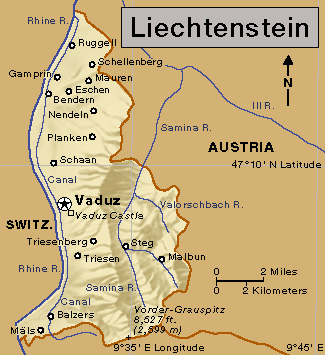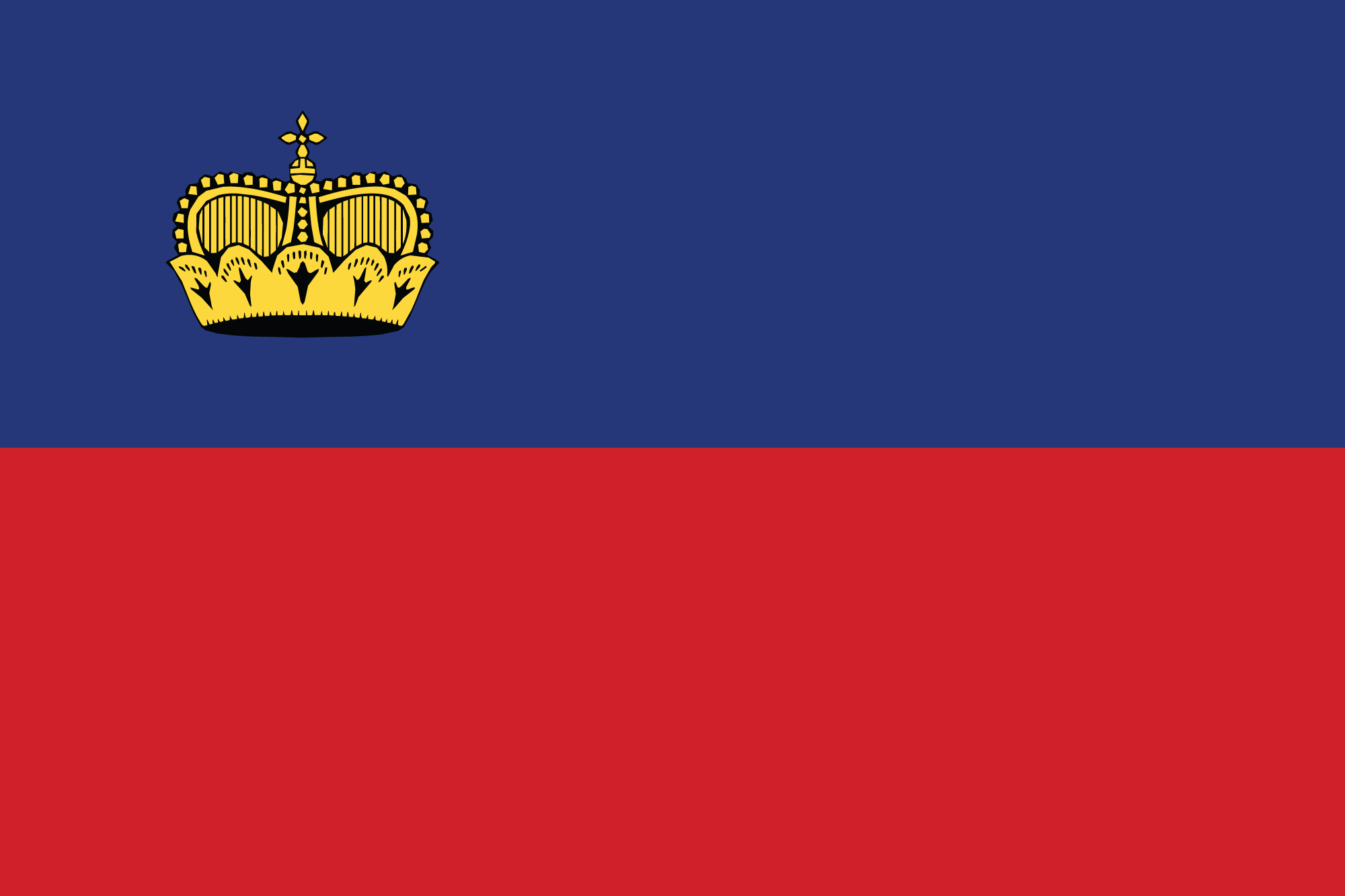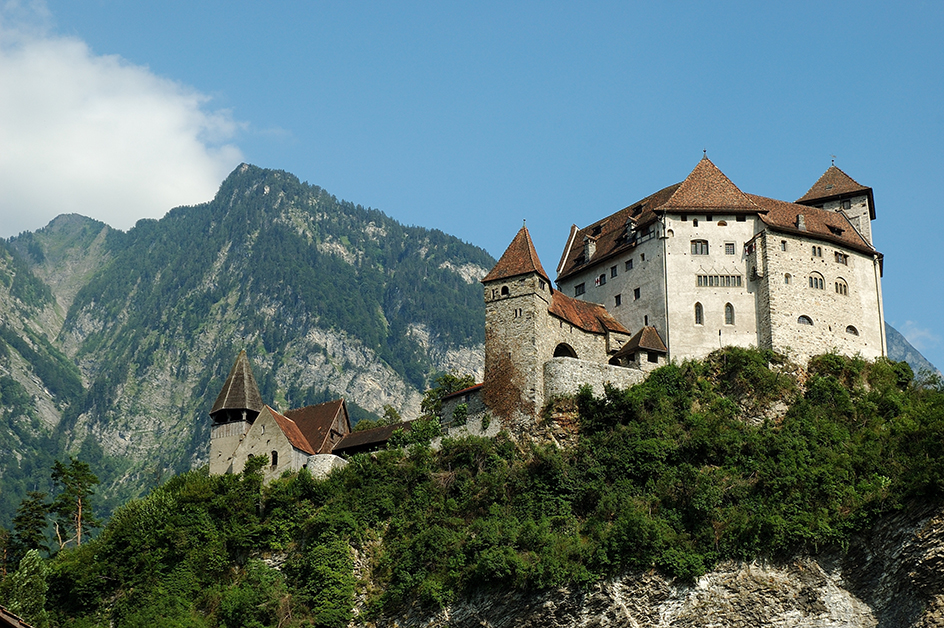Liechtenstein << LIHK tuhn `styn` >> is a tiny country in south-central Europe. It is one of the world’s smallest countries. Liechtenstein covers only 62 square miles (160 square kilometers) and has only about 39,000 people.

Liechtenstein lies along the Rhine River between Switzerland and Austria, and has many close ties with the Swiss. Most of the people speak Alemannic, a German dialect. Liechtenstein uses Swiss money, and Switzerland operates its postal and telephone systems. Switzerland also represents Liechtenstein in the country’s diplomatic and trade relations.
Like Switzerland, Liechtenstein has maintained its neutrality through several wars. Liechtenstein has not fought in a war since 1866. It has been independent since 1806. Its official name in German, the official language, is Fürstentum Liechtenstein (Principality of Liechtenstein). Vaduz is the capital and largest town.
Government.
Liechtenstein is a constitutional monarchy. It is ruled by a prince who is the head of the House of Liechtenstein. The throne usually passes to the prince’s eldest son.

The people elect the 25 members of the Landtag (parliament) to four-year terms. The Landtag passes laws, prepares the national budget, and sets tax rates. Laws must be approved by the prince. A five-member Collegial Board headed by a prime minister handles government operations. Its members are nominated by the Landtag and approved by the prince.
People.
The people in Liechtenstein, like the Austrians and Swiss, are descended from a Germanic tribe that settled in the Alps in the A.D. 400’s. Until the 1930’s, most people farmed for a living. Now, more than half of them are factory workers or craftworkers. Less than 10 percent of the people still farm for a living.
About three-quarters of Liechtenstein’s people are Roman Catholics. Primary and secondary schooling is free, and children must attend school for eight years. Nearly all adults in Liechtenstein can read and write.
One of the world’s finest private art collections is owned by the prince. It is housed in Vaduz and includes works by Pieter Bruegel the Elder, Sandro Botticelli, Rembrandt, and Peter Paul Rubens.
Land.
The Rhine River flows along the western border of Liechtenstein. A narrow strip of flat farmland lies next to the river. Snow-topped mountains cover most of the country’s eastern and southern sections. The mountain slopes are covered with pine forests and fine grazing meadows.

Liechtenstein has a mild climate for a country surrounded by high mountains. Warm spring winds provide good weather for growing fruit. The average yearly temperature is 47 °F (8 °C), and precipitation averages about 35 inches (89 centimeters) a year.
Economy.
Since about 1950, Liechtenstein has changed from a farming country to a highly industrialized one. It has one of the highest standards of living in the world. In 1991, Liechtenstein joined the European Free Trade Association (EFTA), an economic organization of European nations. Liechtenstein has been a member of the European Economic Area, an economic pact between EFTA and the European Union, since 1995. The country exports much more than it imports.
Products made in Liechtenstein include ceramics, dental products, food products, machinery, metal products, pharmaceuticals (medicinal drugs), and precision instruments. Farmers raise dairy cattle in upland meadows; grow grapes and other fruits on upland slopes; and grow barley, corn, potatoes, and wheat in the Rhine Valley. The majority of workers in Liechtenstein’s industries commute every day from nearby countries.
The government collects money by taxing foreign businesses that set up their headquarters in Liechtenstein. Liechtenstein offers low business and income taxes to such companies, and thousands of firms from other countries have headquarters there. The government also makes money by selling postage stamps. Liechtenstein’s stamps are prized by stamp collectors throughout the world. Many of the stamps are reproductions of paintings in the prince’s famous art collection. Tourism is also an important source of income for Liechtenstein.
Trains on the main railroad line from Switzerland to Austria go through Liechtenstein. But only a few trains stop in Liechtenstein. Buses link Liechtenstein with Austria and Switzerland.
History.
Because of its central location in Europe, the area that is now Liechtenstein has been continuously inhabited since 3000 B.C. Charlemagne, king of the Franks, controlled the area in the late A.D. 700’s. After his death in 814, the region was divided into two independent states, Vaduz and Schellenberg. Both states later became part of the Holy Roman Empire. Johann-Adam Liechtenstein, a prince from Vienna, acquired Schellenberg in 1699 and Vaduz in 1712. His descendants still rule Liechtenstein.
Liechtenstein has been an independent state since 1719, except for a brief period during the early 1800’s when Napoleon I of France controlled it. In 1815, Liechtenstein joined the German Confederation, a league of German rulers, but kept its independence. The confederation was dissolved in 1866 at the end of the Seven Weeks’ War. This was the last war in which Liechtenstein fought. It has remained neutral since then and has had no army since 1868. In 1924, Liechtenstein agreed on an economic union with Switzerland. Women did not receive the right to vote in Liechtenstein’s national elections until 1984.
Prince Franz Josef II died in 1989. He was succeeded by his son Prince Hans-Adam II, who had ruled in his place since 1984. The people of Liechtenstein voted in 2003 to give the prince more authority in the government. In 2004, Hans-Adam gave his oldest son, Prince Alois, responsibility for running Liechtenstein’s government. However, Hans-Adam officially remained head of state.
See also Vaduz.
